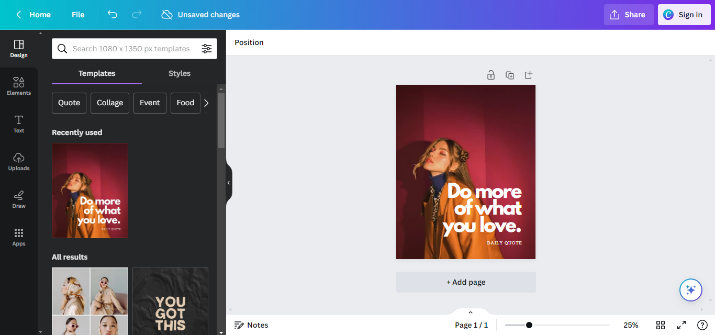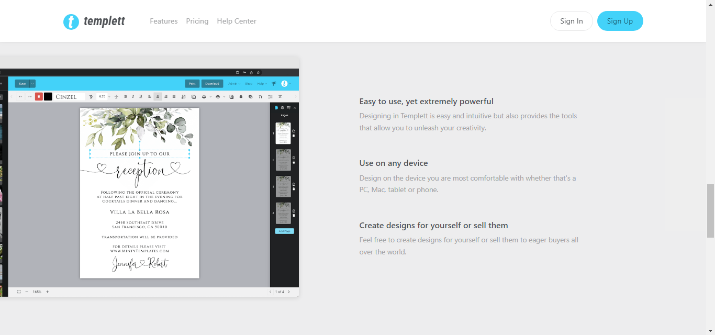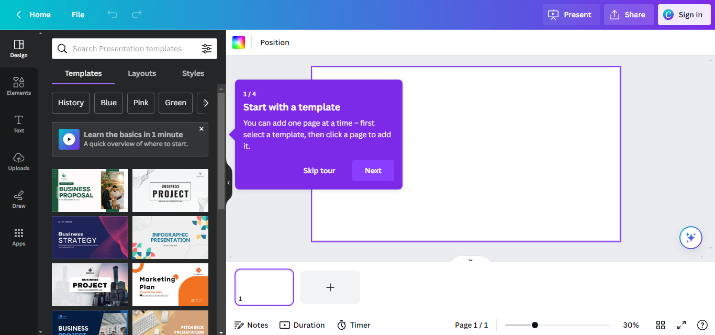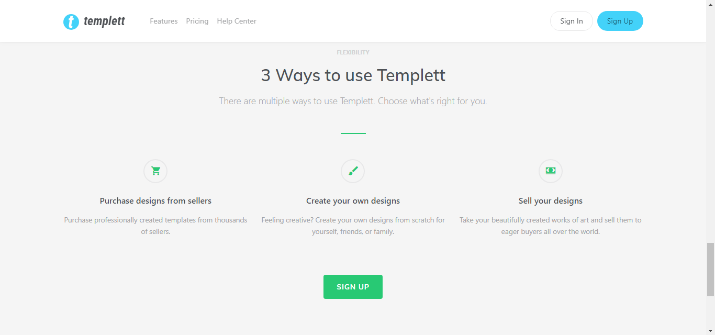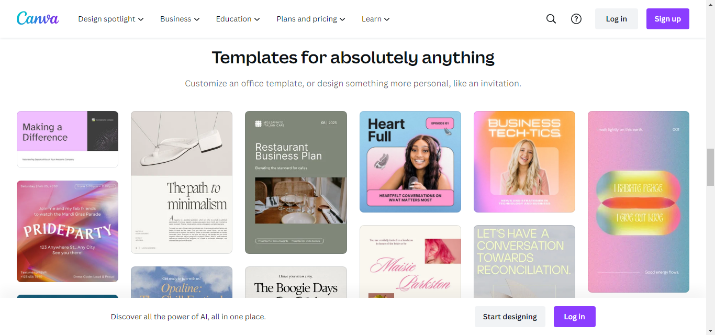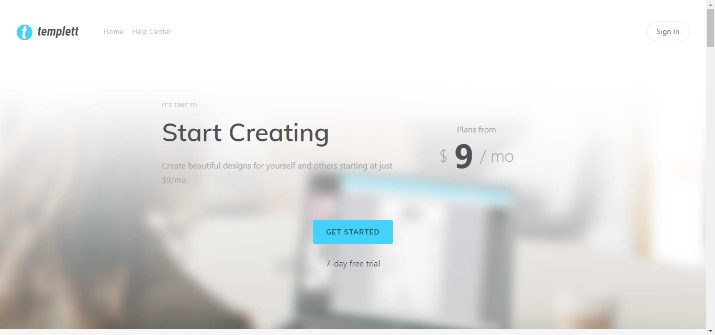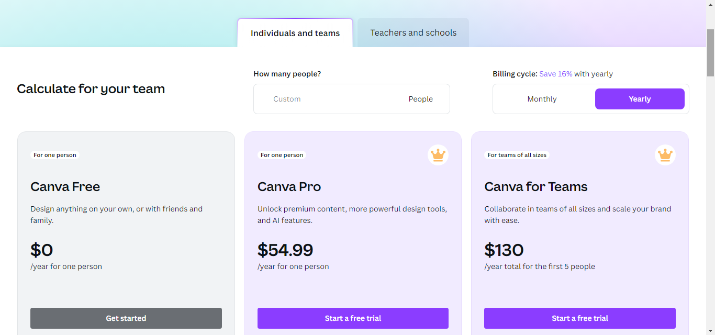Creating a design from scratch is difficult because not everyone has the time or prior design experience.
However, a template streamlines the process; you simply need to customize it to end up with a professional-grade design.
When it comes to creating flawless designs from templates, Templett and Canva are two platforms that come to mind. Anyone can use these tools to create stunning designs in minutes.
If you want to create social media graphics, mind maps, book covers, Zoom virtual backgrounds, magazine covers, infographics, and the like, you can use Canva.
On the other hand, if you are looking to design and sell customizable templates, you will find Templett useful.
Choosing between Canva and Templett can be confusing though, as both work in almost the same way.
But don’t worry; this Templett vs Canva guide compares the two platforms, making it easy for you to choose the perfect design tool for your needs.
Let’s explore the two.
Quick Summary
Canva is the winner because it offers extensive customization options, has more use cases, and has flexible and more inclusive pricing plans than Templett.
Additionally, Canva has a mobile app and up-to-date templates that Templett lacks.
What is Templett?
Templett is a user-friendly, web-based design platform that lets creators make editable templates for their customers to buy and edit.
After creating customizable templates on Templett, you can share the link with your customers, which opens in Templett. The next step is to edit that template, download it in a preferred format, and print it if necessary.
Templett is popular for its easy-to-use interface that allows users to navigate trouble-free. It also saves sellers time, as they only have to create a template once and let customers modify it. They don’t have to spend hours building a design from nothing.
Templett is a versatile design platform with several templates from business cards to wedding invitations. It’s also a flexible platform that lets you upload custom images and fonts or use existing ones.
What is Canva?
Canva is a free online design platform that you can use to make posters, presentations, videos, social media posts, logos, editable templates, and more.
Melanie Perkins, Cameron Adams, and Cliff Obrecht founded Canva in 2012 with the aim of simplifying graphic design so everyone can access it, regardless of design experience.
Canva lets businesses create designs that align with their branding. It has a broad array of elements, including photos, graphics, videos, and text that you can easily modify to create a unique design for your needs.
Canva’s popularity is due to its free plan, free trial for its pro plan, thousands of templates, ease of use, and more. You can sign up and start using it right away.
Templett vs Canva: Features
Templett
- Easy to use: Creating a design is intuitive and offers you the tools needed to exploit your creativity.
- Multi-device support: You can design on a device of your choice, including a phone, Mac, PC, or tablet.
- Predesigned templates: Templett has free stock templates containing pre-filled text, making it easy for you to get started.
- Over 800 free fonts: You get access to 800+ fonts that you can use in designs at no cost.
- Over three million elements: Templett features at least three million images and SVGs that you can use without paying extra.
- Customization options: You can modify the predesigned templates by changing the colors, fonts, text, and images to make your designs more unique.
- Team collaboration: Templett lets team members collaborate on various designs in real time. This feature is useful for marketing teams.
- Seamless sharing: You can share a design via social media, email, or download it in different formats, such as PDF, PNG, and JPG.
AlsoRead: Can You Use Canva Images For Commercial Use?
Canva
- Massive template library: Canva has a wide collection of ready-made templates on different design types, such as social media graphics, posters, marketing materials, presentations, and more.
- Elements: Canva has a broad collection of elements, including video footage, stock photos, icons, graphics, and more. This collection saves you from seeking external resources.
- Customization freedom: You can edit a template by tweaking fonts, layouts, size, background, color palettes, etc. You can also add your own illustrations and images.
- Real-time collaboration: Team members can collaborate on a specific design in real-time, enhancing an efficient workflow.
- Intuitive interface: Canva has a drag-and-drop, user-friendly interface that allows users of any skill level to make and edit a design.
- Sharing: You can share a design through social media and email, download it in different formats, or embed it directly on a website.
Explore: Ways To Superscript In Canva
Templett vs Canva: Ease of Use
Templett
Templett has a user-friendly interface, too, but its primary focus is to create editable templates. Thus, if you want to build a template for a service or product, you’ll find it handy.
Navigating Templett’s interface is easy. The drag-and-drop feature lets you click on images, text, and other elements in templates and drag them to any position on a design.
The professional templates on this platform make it easy for anyone to start creating a design. You simply need to select a template that matches your preferred style and needs.
Canva
Canva is popular for its straightforward interface. The drag-and-drop functionality lets you add elements to new designs effortlessly.
Getting started on the platform is easy too. You simply need to type the name of the design you would like to make and the templates will load. For example, if you want to create a business presentation, type ‘presentation’ in the search bar and you will see the templates under different categories.
Thus, even if you haven’t used graphic design software before, you can use this platform to make professional-style designs.
Moreover, Canva offers various tools that you can use to personalize a design. The tools include image editing, backgrounds, animation, font size and type selection, and color palette, just to mention a few.
Canva’s intuitive interface and design functionalities make it a perfect platform for both newbies and experienced users.
Also Read: Canva Cartoon Effect
Verdict
Both platforms have an intuitive interface with a drag-and-drop option for beginners to start creating designs immediately.
Canva vs Templett: Design Capabilities
Canva
You can use Canva to create a wide range of designs, such as logos, presentations, Instagram stories, posters, flyers, YouTube thumbnails, Facebook posts, invitation cards, invoices, and much more.
There are several templates for each of these designs. Thus, you can select one and modify it by changing colors, fonts, elements, background, etc using the drag-and-drop functionality.
You can also animate your designs to make them visually striking. Canva also allows you to create videos for different platforms, like YouTube and so on.
If you don’t want to create designs from existing templates, you can upload your own files, photos, videos, documents, or audio clips to work with. Plus, you can create a brand kit complete with a logo, colors, and fonts that can be added to your designs.
Once you are happy with your design, you can share or download them in your desired format.
Besides, you can create unique templates and give others access to edit and download.
Explore: Can You Sell Canva Designs On Etsy?
Templett
Do you wish to create and sell customizable templates? Templett is the ideal platform for that. It lets you make editable menus, invitations, and other printable items.
You can choose from a variety of professional templates to create something your customers will love. Modifying the templates entails changing images, colors, fonts, and text.
Templett also lets you upload your own graphics and photos to replace those in a particular template. Besides, integrating a brand kit is possible.
Verdict
Canva has more extensive design capabilities than Templett, which focuses on designing editable templates.
Templett vs Canva: Templates and Customization
Templett
The templates on this platform cover different design needs, from event invitations and marketing materials to presentations and social media posts.
The templates have a professional touch to give your projects an attractive and refined starting point. Such quality and consistency in the templates is for users who lack extensive design skills.
Customizing the templates involves changing fonts where you can upload your own or select from the preloaded fonts. It also entails modifying colors, replacing graphics and images, and editing text.
What makes Templett beginner-friendly is that templates feature predefined styles and layouts without overwhelming customization. Thus, no time to waste on deciding how best to modify a template.
Templett lets you upload branding elements, such as fonts, logos, and colors to enhance consistency.
Explore: How To Identify A Font From An Image In Canva?
Canva
Canva has a wide collection of templates in various design categories, from social media posts to presentations.
The platform stays up-to-date with seasonal themes and current trends, providing an ever-fresh collection of templates that align with popular styles. This feature ensures your creations are suitable and attention-grabbing.
Canva goes beyond replacing images and text and lets you edit layouts by resizing, moving, and repositioning design elements.
Even Canva’s free plan provides a big library of templates for new users and beginners to use. Paid plans have an even more extensive collection of templates that you can customize and use.
Verdict
Both platforms have a vast template library that novice designers can start customizing in no time. However, Templett has limited customization options compared to Canva.
Canva vs Templett: Sharing and Collaboration
Canva
Canva supports design sharing and seamless collaboration. Designs can be shared via email, social media, or by embedding a design link on a website.
After creating a design in Canva, you can collaborate with anyone by sharing a link and letting a user edit the design without even signing in.
Please note, you can only share a design if you own or have edit access to the design.
After opening the design, select ‘share’ and tap on the collaboration link, then select ‘Anyone with the link’. Next, you can select ‘can edit’. And if you want a user to only view without editing, you should select ‘can view’.
After inviting guests to collaborate on a design, they can view, play, or present the design. They can also edit, copy your design link, and see other users’ comments.
Check Out: Best Canva Audio Tracks
Templett
After creating a design in Templett, you can share it with other users. First, you should save the template you would like to share after customizing it. The next step is to click on the template and select Share followed by entering the username of the individual you wish to share with.
If you don’t know a person’s username, you can generate a template link in the demo area and share it with them.
You can provide permissions on what guests can and can’t do after accessing a shared design.
It’s important to note that recipients must have an account on Templett to access the shared template.
Verdict
Both platforms support design sharing and collaboration.
Templett vs Canva: Pricing
Templett
As a template seller, you need to sign up and subscribe to start using this platform.
Templett doesn’t have a forever free plan but it does have three paid plans: Starter, Essential, and Professional.
The Starter Plan costs $9 per month and a $0.79 transaction fee on each template sold.
The Essential Plan costs $29 per month and attracts a transaction fee of $0.49.
The Professional Plan costs $99 per month and if you choose it, you will be required to pay $0.39 per transaction.
The best part is that each of these plans comes with a seven-day free trial.
The pricing page only shows the Starter Plan. You will need to sign up as a seller to see the three plans and all of their features.
Also Read: Why Are My Canva Images Blurry?
Canva
Canva’s pricing is categorized into two groups: individuals and teams and teachers and schools. Primary and secondary teachers can access Canva for free after verification. It is also 100% free for teachers and K-12 students.
On the other hand, Canva has three plans for individuals and teams: Canva Free, Canva Pro, and Canva for Teams.
If you are an individual, you can choose Canva Pro, which costs $54.99 yearly or $6.49 per month per person. If you are a team, then Canva for Teams would do; it costs $130 per year for a team of five or $12.99 per month for five users.
Both Canva Pro and Canva for Teams have a 30-day free trial, which comes with all of the premium features.
Verdict
Canva’s pricing is more flexible and targets a wider variety of users than Templett.
Canva vs Templett: Similarities and Differences
Similarities
- Both support design sharing and collaboration.
- Both have various design capabilities to let users create stunning designs.
- Both let you customize templates by adding elements, shapes, images, text, and colors.
- Both are easy to use, allowing people without previous design skills to create high-quality designs.
- Both have plans that suit specific users with different budgets.
Differences
- Canva focuses on creating various designs from scratch while Templett’s primary aim is the creation and sale of editable templates.
- Templett integrates with Etsy, which means you can sell templates straight from the platform.
- Templett has fewer customization options compared to Canva.
- Canva offers a forever free plan, but Templett doesn’t have a free plan.
- Canva’s free trial lasts 30 days while Templett’s free trial lasts only seven days.
- Canva has Android and iOS apps, but Templett doesn’t.
Wrapping Up
In my opinion, Canva carries the day because it addresses more design needs than Templett’s narrow focus on creating and selling customizable templates.
Canva offers more customization options that go past simply replacing text and images. You can rearrange elements, remove a background, resize, animate designs, and more.
The pricing is more flexible and targets a wider user base than Templett. Teachers, students, schools, school districts, marketing teams, and individual users can benefit from it.
Canva has a mobile app and its templates are frequently updated.
Besides, new users can opt for the forever free plan or a 30-day trial.
However, feel free to choose a platform that aligns with your design needs, purpose, and budget.
Tom loves to write on technology, e-commerce & internet marketing. I started my first e-commerce company in college, designing and selling t-shirts for my campus bar crawl using print-on-demand. Having successfully established multiple 6 & 7-figure e-commerce businesses (in women’s fashion and hiking gear), I think I can share a tip or 2 to help you succeed.



